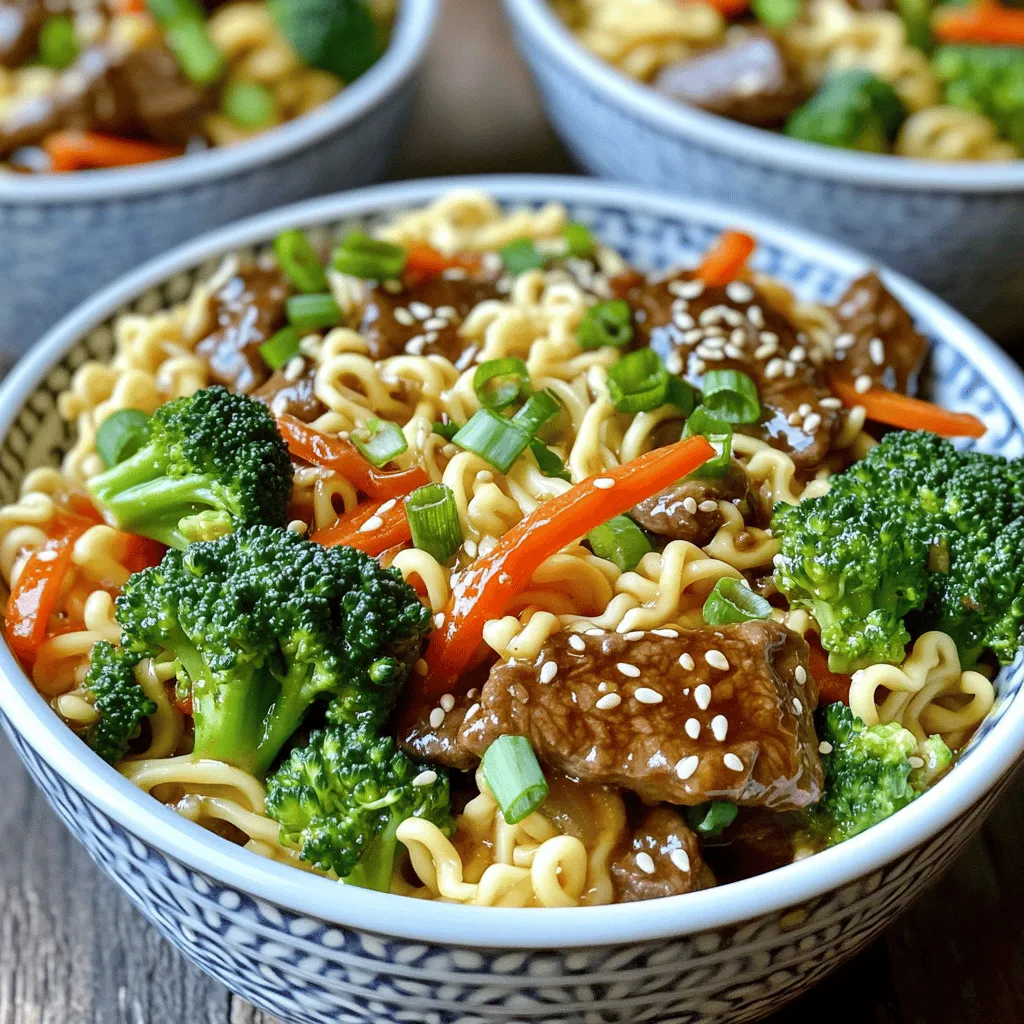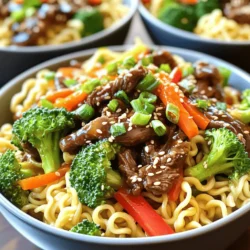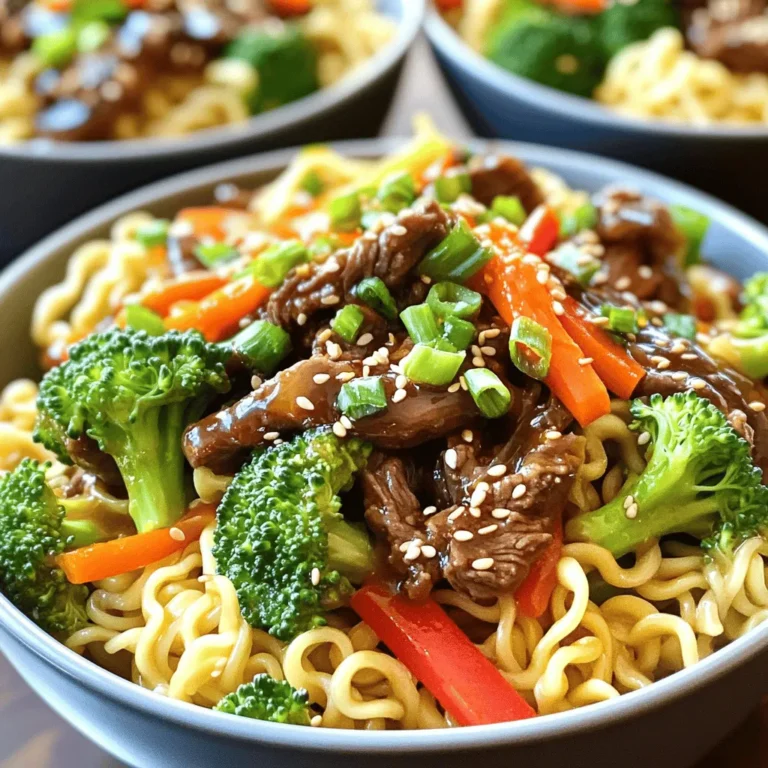Are you ready for a dinner that combines flavor and ease? Mongolian Beef Noodles are a simple yet delicious meal you can make at home. With tender beef, fresh veggies, and savory sauce, this dish pleases everyone. I’ll guide you through each step, from gathering ingredients to plating your meal. Let’s dive into this easy recipe that will transform your weeknight dinners!
Ingredients
To make Mongolian Beef Noodles, you will need these simple ingredients:
– 8 oz. egg noodles
– 1 lb. beef flank steak, thinly sliced
– 3 tablespoons low-sodium soy sauce
– 1 tablespoon hoisin sauce
– 2 tablespoons brown sugar
– 1 tablespoon cornstarch
– 2 tablespoons vegetable oil
– 1 cup broccoli florets
– 1 red bell pepper, sliced
– 1 medium carrot, julienned
– 3 green onions, chopped
– 2 cloves garlic, minced
– 1 teaspoon fresh ginger, grated
– Sesame seeds for garnish (optional)
These ingredients blend to create a dish full of flavor. The beef adds richness. The vegetables bring color and crunch. The sauces provide a sweet and salty balance. You can find most of these items in your local grocery store. If you want to add a bit of flair, try using fresh vegetables from a farmer’s market. For the full recipe, follow the steps carefully to ensure a delicious meal.
Step-by-Step Instructions
Preparation of Ingredients
How to cook the noodles properly
To cook the egg noodles, follow the package directions. Boil water, add noodles, and cook until tender. This usually takes about 5-7 minutes. Drain the noodles well, ensuring they do not stick together. Rinse them with cold water to stop the cooking process.
Marinating the beef effectively
For the beef, slice flank steak thinly against the grain. This makes it more tender. In a bowl, mix soy sauce, hoisin sauce, brown sugar, and cornstarch. Whisk until smooth. Add the beef slices and coat them well. Let the beef marinate for 15-20 minutes. This step enhances the flavor.
Cooking Process
Stir-fry techniques for perfect beef
Heat vegetable oil in a large skillet over medium-high heat. Once the oil is hot, add the marinated beef. Discard any extra marinade. Stir-fry the beef for about 3-4 minutes. Cook until the beef is browned and cooked through. Remove the beef from the skillet and set it aside.
Cooking vegetables without losing crunch
In the same skillet, add broccoli, red bell pepper, carrot, garlic, and ginger. Stir-fry these vegetables for about 3-5 minutes. Make sure they stay tender yet crunchy. The quick cooking time helps keep their bright colors and nutrients.
Combining ingredients for optimal flavor
Return the cooked beef to the skillet with the vegetables. Add the cooked noodles and any remaining marinade. Toss everything together gently. Cook for an additional 2-3 minutes until everything is well mixed and heated through.
Finishing Touches
Adding green onions for freshness
Remove the skillet from the heat and stir in chopped green onions. They add a fresh burst of flavor.
Plating and garnishing suggestions
Serve the Mongolian Beef Noodles hot in deep bowls. For a nice touch, garnish with extra green onions and a sprinkle of sesame seeds. This makes your dish look appealing and inviting. For the full recipe, check the details above.
Tips & Tricks
Achieving Authentic Flavors
For great taste, use high-quality soy sauce, like Kikkoman or Lee Kum Kee. Their rich flavor adds depth to your dish. Hoisin sauce is another key. I recommend Lee Kum Kee for its sweetness and savory notes. Tweak the amount of soy sauce and hoisin sauce to match your taste. If you want it sweeter, add more brown sugar. For a salty kick, increase the soy sauce.
Cooking Techniques
Stir-frying is an art that requires heat and speed. Use a large skillet or wok and heat it well before adding oil. This helps create a nice sear on the beef. Cut the beef against the grain. This makes it tender and easy to chew. Aim for thin slices, about a quarter-inch thick. This ensures quick cooking and keeps the meat juicy.
Presentation Tips
For serving, opt for deep bowls. They add comfort and style to your dish. Add a few extra slices of green onion on top for color. A sprinkle of sesame seeds adds a nice touch too. Think about using chopsticks for serving. It can make the meal more fun and authentic. Enjoy showing off your beautiful Mongolian Beef Noodles!

Variations
Alternative Ingredients
You can change up the vegetables in this dish easily. Try adding snap peas, bok choy, or mushrooms. Each veggie brings its own flavor and texture. You can also swap the beef for chicken, shrimp, or tofu. Each protein will give your dish a new twist.
Flavor Enhancements
Want more heat? Add red pepper flakes or sliced jalapeños. These spices will spice up your meal. You can also mix in oyster sauce or chili garlic sauce. These sauces deepen the flavor and add richness.
Dietary Modifications
For gluten-free options, use rice noodles instead of egg noodles. They work just as well and taste great. If you need low-sodium alternatives, look for low-sodium soy sauce. You can also use coconut aminos for a different flavor. Check the Full Recipe for more details!
Storage Info
Storing Leftovers
To keep your Mongolian Beef Noodles fresh, store them in the fridge. The ideal temperature is below 40°F (4°C). Use airtight containers to prevent moisture loss. Glass or plastic containers work well. Make sure to cool the noodles before sealing the container. This helps avoid soggy noodles.
Reheating Tips
Reheat your noodles using a skillet. Heat over medium-low heat. Add a splash of water or broth to keep them moist. Stir the noodles gently as they heat. You can also use a microwave. Place the noodles in a bowl and cover with a damp paper towel. Heat for one to two minutes, checking often. This way, you keep the texture and flavor intact.
Freezing Instructions
If you want to freeze Mongolian Beef Noodles, pack them tightly in freezer-safe bags. Remove as much air as possible to avoid freezer burn. Label the bags with the date. They stay fresh for up to three months. To thaw, place them in the fridge overnight. Reheat as explained above. This keeps your dish tasty and enjoyable. For the full recipe, refer to the main article.
FAQs
What is the best cut of beef for Mongolian Beef Noodles?
The best cut is flank steak. It is tender and flavorful. You should slice it thinly against the grain. This cut cooks quickly and stays juicy. Other good options are sirloin or ribeye. They offer great taste too.
Can I make Mongolian Beef Noodles ahead of time?
Yes, you can make it ahead. Cook the noodles and beef, then cool them. Store in the fridge for up to two days. When ready, reheat in a skillet. Add a splash of water to keep it moist. Fresh veggies can be added just before serving.
How spicy is Mongolian Beef Noodles?
Mongolian Beef Noodles are not very spicy. The dish is more sweet and savory. You can adjust the spice level. Add chili flakes or sriracha for heat. This lets you customize it to your taste.
Where can I find Mongolian Beef Noodles in restaurants?
Many Asian restaurants serve it. Look for places that offer Mongolian dishes. Noodles are often included on the menu. Check online reviews to find the best spots. You might also find it in fusion restaurants.
Can I substitute chicken or tofu instead of beef?
Yes, chicken or tofu work well as substitutes. Use chicken breast for a lean option. Tofu is great for a vegetarian dish. If using tofu, press it to remove water first. This helps it absorb flavors better.
What can I serve with Mongolian Beef Noodles?
You can serve it with steamed rice or fried rice. A side of stir-fried vegetables adds color and crunch. Spring rolls or dumplings are great appetizers too. For a refreshing touch, try a simple salad. You can also enjoy it with a hot soup. For the full recipe, check the section above.
In this article, we explored how to make delicious Mongolian Beef Noodles. We discussed the key ingredients, proper cooking techniques, and helpful tips to enhance your dish. Remember, the right cut of beef and fresh veggies are vital for great flavor. You can also make substitutions or add spice to fit your taste. Keep these pointers in mind as you cook. Enjoy mastering this dish in your kitchen! Your meals can be exciting and satisfying with just a little effort.


